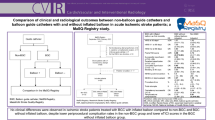Abstract
Purpose:
The object of this study was to assess the level of embolization in the embolized artery and the degradation period of these two embolic agents in the renal arteries using rabbit models.
Materials and Methods:
The renal artery was embolized using 5 mg of gelatin microspheres (GMSs; diameter, 35–100 μm; group 1) or 1 mg of Gelpart (diameter, 1 mm; group 2). For each group, angiographies were performed on two kidneys immediately after the embolic procedure and on days 3, 7, and 14 after embolization. This was followed by histopathological examinations of the kidneys.
Results:
Follow-up angiograms on each day revealed the persistence of poorly enhanced wedge-shaped areas in the parenchymal phase in all cases. In group 1, four of six cases showed poorly enhanced small areas in the follow-up angiograms. In group 2, all cases showed poorly enhanced large areas. In the histopathological specimens, it was observed that immediately after embolization, the particles reached the interlobular arteries in group 1 and the interlobar arteries in group 2. In all cases in group 1, the particles were histologically identified even on day 14. In one case in group 2 on day 14, the particles were not identified.
Conclusion:
In conclusion, although GMSs and Gelpart were similar in the point of gelatin particles, the level of embolization and the degradation period were different between GMSs and Gelpart.




Similar content being viewed by others
References
Feldman F, Casarella WJ, Dick HM, Hollander BA (1975) Selective intra-arterial embolization of bone tumors. A useful adjunct in the management of selected lesions. Am J Roentgenol Radium Ther Nucl Med 123:130–139
Rosch J, Dotter CT, Brown MJ (1972) Selective arterial embolization. A new method for control of acute gastrointestinal bleeding. Radiology 102:303–306
Pugatch RD, Wolpert SM (1975) Transfemoral embolization of an external carotid-cavernous fistula. Case report. J Neurosurg 42:94–97
Kunstlinger F, Brunelle F, Chaumont P, Doyon D (1981) Vascular occlusive agents. AJR 136:151–156
Spies JB, Benenati JF, Worthington-Kirsch RL, Pelage JP (2001) Initial experience with use of tris-acryl gelatin microspheres for uterine artery embolization for leiomyomata. J Vasc Interv Radiol 12:1059–1063
Jiaqi Y, Hori S, Minamitani K, et al. (1996) A new embolic material: super absorbent polymer (SAP) microsphere and its embolic effects. Nippon Igaku Hoshasen Gakkai Zasshi 56:19–24
Coley SC, Jackson JE (1998) Endovascular occlusion with a new mechanical detachable coil. AJR 171:1075–1079
Tabata Y, Uno K, Ikada Y, Muramatsu S (1988) Potentiation of antitumor activity of macrophages by recombinant interferon alpha A/D contained in gelatin microspheres. Jpn J Cancer Res 79:636–646
Tabata Y, Ikada Y (1989) Synthesis of gelatin microspheres containing interferon. Pharm Res 6:422–427
Tabata Y, Uno K, Muramatsu S, Ikada Y (1989) In vivo effects of recombinant interferon alpha A/D incorporated in gelatin microspheres on murine tumor cell growth. Jpn J Cancer Res 80:387–393
Tabata Y, Miyao M, Inamoto T, et al. (2000) De novo formation of adipose tissue by controlled release of basic fibroblast growth factor. Tissue Eng 6:279–289
Tabata Y, Hong L, Miyamoto S, Miyao M, Hashimoto N, Ikada Y (2000) Bone formation at a rabbit skull defect by autologous bone marrow cells combined with gelatin microspheres containing TGF-beta1. J Biomater Sci Polym Ed 11:891–901
Kushibiki T, Matsumoto K, Nakamura T, Tabata Y (2004) Suppression of the progress of disseminated pancreatic cancer cells by NK4 plasmid DNA released from cationized gelatin microspheres. Pharm Res 21:1109–1118
Ozeki M, Tabata Y (2005) In vivo degradability of hydrogels prepared from different gelatins by various cross-linking methods. J Biomater Sci Polym Ed 16:549–561
Ohta S, Nitta N, Takahashi M, Murata K, Tabata Y (2007) Degradable gelatin microspheres as an embolic agent: experimental study in rabbit renal model. Korean J Radiol (in press)
Yamada R, Sawada S, Uchida H, Kumazaki T, Hiramatsu K, Ishii H, Nakao N, Nakamura H, Taguchi T (2005) Clinical study of porous gelatin sphere (YM 670) in transcatheter arterial embolization. Gan To Kagaku Ryoho 32(10):1431–1436
Goldstein HM, Wallace S, Anderson JH, Bree RL, Gianturco C (1976) Transcatheter occlusion of abdominal tumors. Radiology 120:539–545
Author information
Authors and Affiliations
Corresponding author
Rights and permissions
About this article
Cite this article
Ohta, S., Nitta, N., Sonoda, A. et al. Embolization Materials Made of Gelatin: Comparison Between Gelpart and Gelatin Microspheres. Cardiovasc Intervent Radiol 33, 120–126 (2010). https://doi.org/10.1007/s00270-007-9139-x
Received:
Revised:
Accepted:
Published:
Issue Date:
DOI: https://doi.org/10.1007/s00270-007-9139-x




